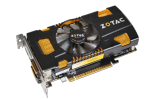3. Metodologia di test
Configurazione di prova
Per valutare le prestazioni delle schede video di ultima generazione abbiamo assemblato un sistema particolarmente potente dotato di una CPU Core i7 920, preventivamente overcloccata a 4 GHz, 6GB di Ram Corsair Dominator e un alimentatore Corsair HX1000.
Â
| Processore | Intel Core i7 920 @ 4 GHz (200*20) |
| Scheda Madre | Gigabyte X58 Extreme |
| Memoria RAM | 3*2 GB Corsair Dominator TR3X6G1600C7D |
| Hard Disk | Corsair Force Series CSSD-F60GB2 Western Digital VelociRaptor 150GB |
| Alimentatore | Corsair HX1000 |
| Sistema Operativo | Microsoft Windows 7 Ultimate 64 bit |
| Monitor | Samsung SyncMaster 2443BW |
Â
Ai fini comparativi abbiamo incluso nei grafici le seguenti schede video:
Â
| Schede Video NVIDIA | Schede Video ATI |
| NVIDIA GeForce GTX 560 1024 MB NVIDIA GeForce GTX 460 1024 MB NVIDIA GeForce GTS 450 1024 MB |  AMD Radeon HD 6870 1024 MB AMD Radeon HD 6850 1024 MB Sapphire Radeon HD 5770 1024 MB Flex  |
Â
Driver utilizzati
Driver NVIDIA: GeForce 266.58 WHQL, 266.66 WHQL e 267.59 (GeForce GTX 550 Ti)
Driver AMD: AMD Catalyst 11.2 WHQL
Â
Batteria di test
Tutti i giochi sono stati testati alle risoluzioni 1280x1024, 1680x1050, 1920x1200 con le impostazioni di seguito riportate:
- Futuremark 3DMark Vantage â DX10 â Profili Performance, High ed Extreme
- Futuremark 3DMark 11 â DX11 â Profili Performance ed Extreme
- Unigine Heaven BenchMark 2.1Â â DX11Â â Tessellation Normal
- The Last Remnant â DX9.0c
- Call of Duty 4: Modern Warfare â DX9.0c â Qualità Massima AA4x
- FarCry 2 â DX10 â Qualità Massima AA4x
- Tom Clancyâs H.A.W.X. â DX10.1 â Qualità Massima AA4x
- Resident Evil 5 â DX10 â Qualità Massima AA4x
- Crysis â DX10 â Qualità Massima NOAA e AA4x
- Crysis WarHead â DX10 â Qualità Massima NOAA e AA4x
- Mafia 2 â DX10 â Qualità Massima AA4x
- Metro 2033 â DX11 â Qualità High
- Lost Planet 2 â DX11 â Qualità Massima No AA, Test A
Â
Â









